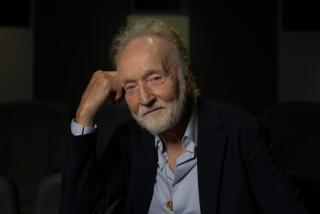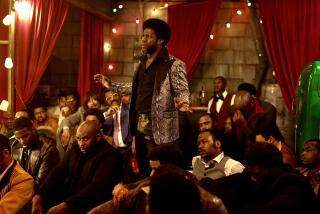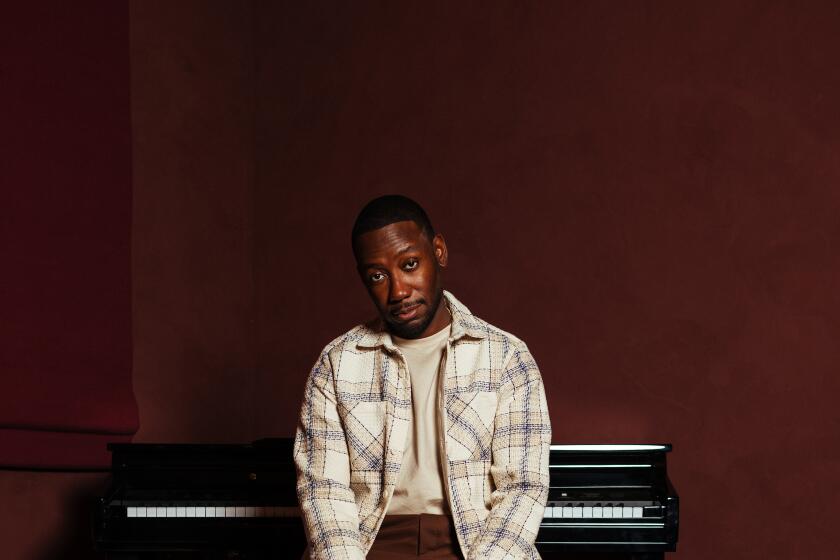Walter Hill Rides Again : ‘Wild Bill,’ the action director’s latest effort, breaks out of saloon territory to explore the fields of moral ambiguity.
It’s not exactly the shootout at the O.K. Corral, but this showdown is even more of a classic--the hallowed war between the sexes.
On one side is a particularly grizzly Jeff Bridges, huddling over a bar table in his Wild Bill Hickok best, or worst, as the case may be--droopy mustache and stringy Western coif. He’s being stalked by Ellen Barkin, who has developed some fancy gunslinging moves for her role as Calamity Jane in the spring film “Wild Bill.”
“It’s better to forgetcha than regretcha,” she twangs at Bridges’ hunched back, then seconds her emotion with gunfire (it misses).
For a low-life saloon, the Warner Bros. sound-stage resembles something much loftier. The set and cast are all swathed in the faded ocher of memory, providing the sort of visual feast that has earned Walter Hill a reputation as a stylish director.
And if Hill were not today in director’s blues--jeans and cotton shirt that are at odds with the sepia set--you might take him for one of those buzzards of the Old West who’ve lassoed his imagination. As Bridges loads his pistol, the bearish and bearded Hill looks on, idly shuffling a deck of cards. Between rehearsals, Hill tucks a poker chip into a barmaid’s green satin bosom. And when everyone breaks for lunch, Hill looks up in triumph at a bar balcony full of foreign journalists.
“Did I exaggerate how much he looks like Wild Bill?” he says.
Authenticity may be in the eye of the beholder, but it’s key to Hill’s latest New Western, a genre that has been reinventing itself by roping in reality. “Wild Bill” breaks out of saloon territory to such real-life frontier settings as a doctor’s office, a sanitarium and an opium den. The white hats and black hats have turned shades of gray as the latest crop of films becomes infused with moral ambiguity and gunslingers turn out to be made of not just blood, but flesh too.
But for tests of bravery, look no further than the filmmakers: They’re making the $30-million film of the frontier lawman’s legendary life just as signs of Western burnout are tailing the stampede of post-”Dances With Wolves” movies. Lawrence Kasdan’s $60-million “Wyatt Earp,” released in June, roped in a paltry $25 million. And TriStar pushed back the release of Sam Raimi’s “The Quick and the Dead” from the fall to February, in part to separate the Sharon Stone vehicle from the rest of the Western pack.
Hill’s last Western, 1993’s “Geronimo,” took in only $18.4 million at the domestic box office in the face of tepid reviews. Hill, 52, says he was disappointed by the anemic showing of “Geronimo,” a revisionist epic that peeled back the complex moral layers of both the cavalry and the Chiricahua Apache leader. But he writes it off to bad timing. The film was released a week after the TNT cable network unveiled its own “Geronimo.”
“I don’t think there are a hell of a lot of movies where you can take basically the same story, show it to 50 million people and bring yours out a week later and think that you’re going to do great. What can you say, ‘My Geronimo has better locations?’ ”
Hill and “Wild Bill” producers Richard and Lili Fini Zanuck are betting against burnout.
“I don’t believe it’s true,” says Richard Zanuck. “If you make a good picture and have a compelling story to tell, it’s going to work. I don’t believe that any genre dies. It just has to be fed with good product.”
*
Hill says: “I think that anybody who says they can predict how something’s going to do, I haven’t met the person yet who had any real degree of accuracy. The only thing for sure is that (Steven) Spielberg’s films do well. He’s the most consistent commercial director in the history of movies, and everybody else is fairly problematical.”
Indeed, Hill’s own career has been spotty ever since his 1984 buddy action hit “48 HRS.” catapulted Eddie Murphy to stardom. His earlier films had already crowned him the critics’ action darling for his poetically choreographed sequences of chase and confrontation. The bloody Minnesota Northfield raid sequence of “The Long Riders,” the first Western that Hill directed, is considered a classic. Michael Sragow, writing in American Film, called it “the most ambitious slow-motion shootout since (Sam) Peckinpah’s ‘Wild Bunch.’ ”
Pauline Kael raved about Hill’s gritty gang spectacle “The Warriors” (1979), a fantasy retelling of Xenophon’s “Anabasis,” likening the film’s atmosphere to that of “The Third Man.”
But the string of films that followed--which included “Crossroads,” (1986), “Red Heat” (1988) with Arnold Schwarzenegger, and “Another 48 HRS.” (1990)--didn’t live up to that early critical and commercial promise, prompting some critics to paint the director with such adjectives as “underrated” and “neglected.” Hill defends his films as leaning “well into the profit side,” but he’s philosophical about the turn his career has taken.
“I think every director thinks that he hasn’t been allowed to make the films he wanted to make. I certainly haven’t been able to make as many Westerns as I’ve wanted,” he says in his office at Warner Bros., amid walls attesting to his passion for Westerniana--drawings of bowie knives, Sioux chief Red Cloud and General George Armstrong Custer.
“(But) sometimes staying alive in a career sense is very important, and you think, ‘Maybe I’ll do this, which will do well and allow me to do that.’ It’s very easy to miscalculate. It’s a dangerous game. But I think in the end, none of us have anybody to blame except ourselves. It can be very hard. The kinds of things that directors most want to do are usually not things the studio perceives to be commercially viable. It really is that simple. Is that true of me? Sure. Absolutely. But it’s no more true of me than 50 other people I know.” And if commercial success means pumping up his films to resemble the technological action blowouts of the past decade, Hill will pass.
*
“I admire a lot of what’s going on out there, but the oversize kind of cartoon action movies is not something I’m terribly comfortable with. I think what I do is much more in the tradition that the bullets are real and they’ll knock you down. I used to really get criticized for my lack of realism, but now I think my films are perceived to be vastly more realistic than most of the action movies that are happening out there.”
A devotee of John Ford and Howard Hawks, Hill says he still prefers the kind of action films he was weaned on.
“I think one of the things about being a director is, you should always try to re-create within yourself the kind of emotions you had watching film when you were very young. The kind of action movies that I always liked, the kind of comic books I always liked, were the serious ones. The characters were very realistic within the framework of the drama, and that kind of action movie interests me a lot more than the super-heroes. And so in that sense, maybe I’m slightly out of step, I suppose, but so be it.”
Hill has always taken a lone horseman approach to things. The son of a Long Beach aircraft factory worker, he opted for college in Mexico City because “it was as far as I could go from Long Beach with very little money and be someplace else.” Hill earned a master’s degree in American history at Michigan State University, and since he was eyeing a career in journalism, he never went to film school. He happened into films when a friend who was a subcontractor at Britannica Films asked him to do research on historical re-enactments.
Hill tried his hand at scripts, and his 1972 screenplay for Sam Peckinpah’s “The Getaway” with Steve McQueen gave him the clout to direct. He now has a two-year production deal at Paramount with his wife and producing partner, Hildy Gottlieb, a former ICM agent. They live in Beverly Hills with their three children.
Hill’s track record of testosterone-driven films prompted the Zanucks to approach him last November with a Pete Dexter script about Hickok culled from “Deadwood,” Dexter’s book about the South Dakota town where the gunslinger was shot dead.
“He’s a gutsy director,” Zanuck says. “He’s kind of a male-oriented director, and he has great knowledge of the West and all of the folklore and all of the heroes.”
As it happened, Hill had been working on his own script about Hickok since 1980, when he saw Joseph Papp’s New York production of Thomas Babe’s play “Fathers and Sons.” Babe’s tragicomic play centered on Hickok’s last days in Deadwood, placing the action in the saloon where he was killed. Hill obtained the rights and opened up the script, adding famous incidents in Hickok’s life and later incorporating elements of a Ned Wynn screenplay, “Hickok.”
When the Zanucks appeared with the Dexter script, Hill folded material from it into his own. They met with John Calley, president of United Artists, and the film was green-lighted at the end of January. With Bridges and Barkin swiftly recruited, the three-month shooting schedule began in May, and the film is now in the dubbing stage.
The filmmakers had considered shooting at the Santa Fe-area sites where “Wyatt Earp” and “Tombstone” were filmed, but production costs kept the crew in Los Angeles. Western streets were reshaped at Universal and Warner Bros. studios, and the Gene Autry Melody Ranch in Santa Clarita was transformed into Deadwood.
“Wild Bill” is told through flashbacks and playbacks in a New York theater, using Hickok’s Wild West show as a springboard to segue to the bruising incidents that inspired it. The movie pivots on a romantic relationship Hickok had with Susannah Moore after the Civil War, which ended tragically. Her son seeks revenge for Hickok’s abandoning her, but making moral matters muddier, Moore had already forgiven Hickok.
Barkin plays the gunslinging Calamity Jane, in a departure from her siren roles.
“I loved the script a lot, and I had worked with Walter Hill before (in ‘Johnny Handsome’) and I had a great time,” she says. “I always feel he has great confidence in my ability, and that makes me feel powerful as an actor.”
For the role of the gruff-but-sensitive Calamity Jane, the former tomboy told “Entertainment Tonight” she underwent some transformation: “I guess now I’m a tom-man.”
*
“We posit an ongoing relationship with Calamity Jane, which is of course part of the legend but under much dispute by most historians of Hickok and the time,” Hill says. “There’s no question that there was a Calamity Jane and that she was a rather extraordinary personality--she swore like a man, drank like a man, shot guns like a guy--but whether or not they actually ever had a romance is very much in dispute. It’s the old thing that if you have a choice between the fact and the legend, you print the legend and move on.”
Hickok’s awareness of his own legend fascinates Hill, who has long pooh-poohed Freudian underpinnings of character. He says “Wild Bill” is about “character rather than incident. Because I think it’s not so much the fights, it’s his personality, his sense of humor about himself. He seemed to understand his own legend. He both fueled it and was a prisoner of it, that it was his raison d’etre, and at the same time he felt himself very constrained by it.”
On a more basic level, Hill sees Westerns as the mother lode of American drama, the archetype from which other forms spring. “Westerns are kind of a stripped-down form, aren’t they? I think they’re the closest thing we have to Greek drama. They become character and narrative exercises that are away from the constraints of the official strictures of society. It’s all about behavior in an area where the government is weak . . . the absence of government institutions as people move through a strange and new environment sparsely peopled by human beings of entirely different cultures. But I think a peculiar American genius worked this out with many hands and many minds and I think that’s why it’s endlessly fascinating to us.”
More to Read
Only good movies
Get the Indie Focus newsletter, Mark Olsen's weekly guide to the world of cinema.
You may occasionally receive promotional content from the Los Angeles Times.










